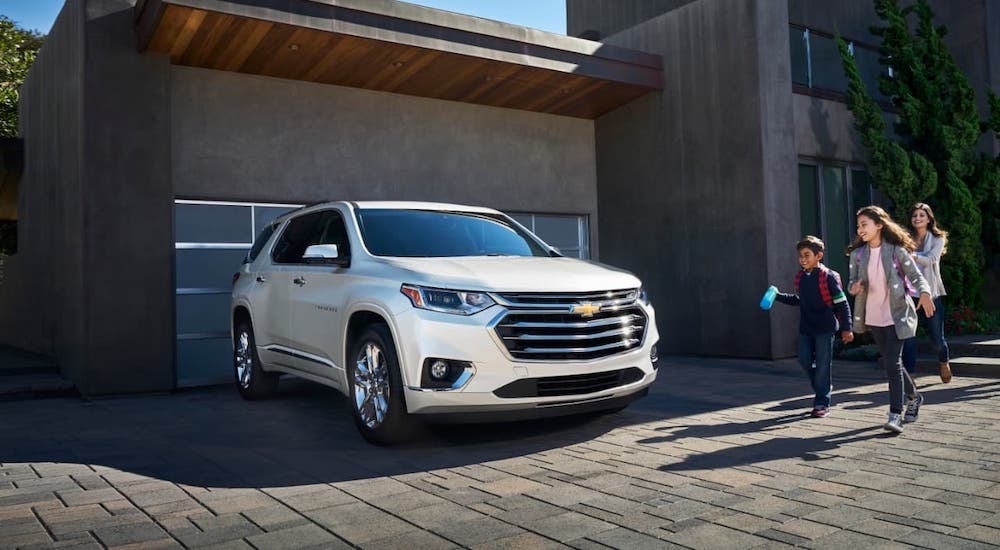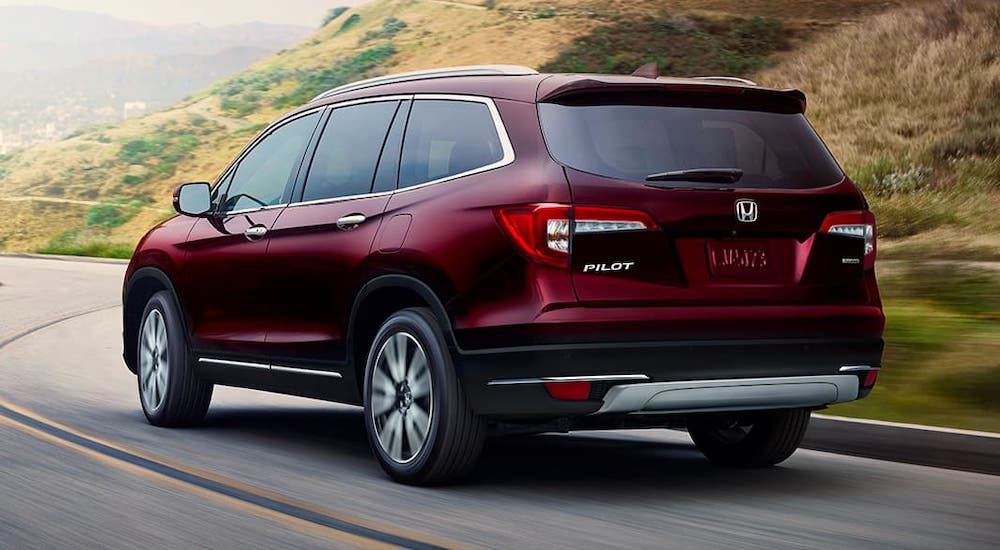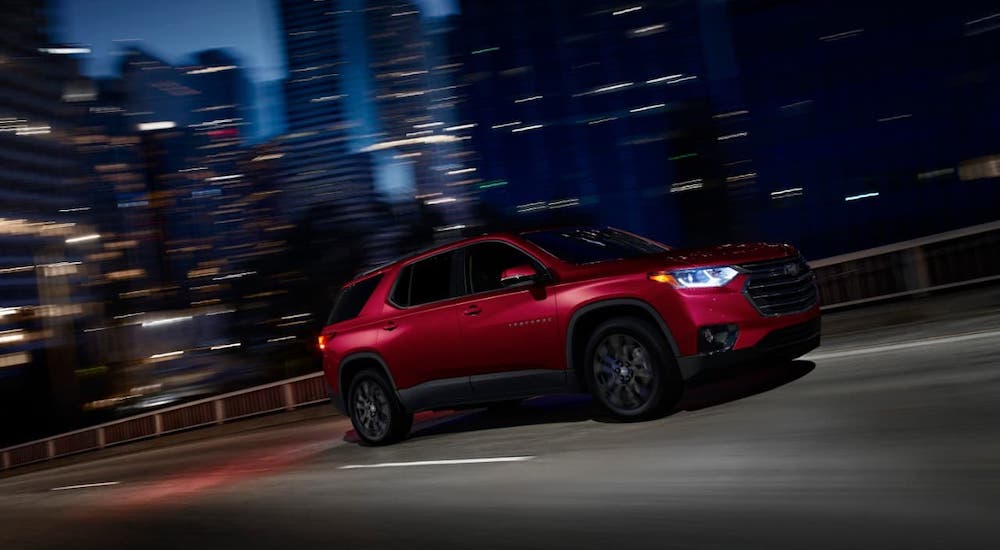There’s no denying that SUVs have yet to lose market dominance ever since their initial boost in popularity in the late 1990s to the early 2000s. Today, the average SUV is far superior to any of its predecessors in a multitude of different ways. It’s almost as if the formula behind an SUV’s design philosophy has been nearly perfected, and we’ve got some amazing results out of this. Two excellent candidates for the best SUV that need to be compared are the 2021 Chevy Traverse vs 2021 Honda Pilot. With these two midsize SUV models sharing the limelight, both from prestigious and well-known manufacturers, how exactly do they compare? Let’s take a closer look and find out.
First, when beginning the shopping process, you’ll instantly notice that Chevy’s offering starts at a much lower price, with a starting MSRP of $29,800. In comparison, Honda’s vehicle starts at an MSRP of $32,550. This would normally not be an issue if the Pilot was able to offer customers a better driving experience than its competition. However, our findings suggest this isn’t the case. Not only this, but more quality-of-life improvements are immediately noticeable in the Traverse, especially upon closer examination of the two vehicles’ base trims.
Which SUV is More Powerful?
Interestingly, the 2021 Traverse and Pilot utilize very similar powertrains. However, the Traverse features a slightly larger engine, which in turn results in noticeably greater performance. Inside of the Pilot, you’ll find a 3.5L V6 that comes paired with a 9-speed automatic transmission and produces 280 hp and 262 lb-ft of torque. Of course, this performance is nothing to look down on, but it doesn’t hold up as well as what you get from the 3.6L V6 powering the Traverse. That engine, also paired with a 9-speed automatic transmission, can produce an impressive 310 hp and 266 lb-ft of torque. On top of a small but welcome bump in torque output, that is a full 10.7% increase to horsepower.
Fuel efficiency is a large part of a vehicle’s success, and this is only going to become more of a factor over time. While the Traverse’s larger engine can assist in boosting performance, it does come with slightly decreased EPA-estimated ratings over the Pilot’s V6. However, the difference is surprisingly small, with the two vehicles even earning the same 27 MPG highway fuel economy ratings. The commonalities of these two SUVs continue, with both vehicles supporting a maximum towing capacity of 5,000 lbs when properly equipped. With these similarities and differences in mind, we recommend the Traverse for its superior performance at a lower price.
Sizes and Interiors
Much like the performance situation between these two vehicles, their interiors also share a host of differences and similarities. For example, since both of these vehicles are midsize SUVs, they offer three rows of seating as opposed to only two. Both the Pilot and Traverse also have a maximum seating capacity of eight passengers.
However, just because their capacities are the same, this doesn’t mean they’re created equal, and you’ll likely prefer the Traverse’s larger cabin. This is because the Traverse manages to offer more space in general. For example, the Pilot offers 40.1-inches of headroom to the front-row, along with 40.9-inches of legroom, as opposed to the Traverse’s 41.3-inches of front-row headroom and 41-inches of legroom.
Second and third-row seating is treated to a similar amount of head and legroom in both vehicles, and the difference there is rather minuscule. Inside of the Pilot, passengers located in the second-row will have 40.2-inches of headroom and 38.4-inches of legroom, while those same passengers would see a very similar 40-inches of headroom and an identical 38.4-inches of legroom. However, in the third-row seats, the Traverse has 33.5-inches of legroom while the Pilot only has 31.9-inches. That is a sizable difference that helps make the Traverse the superior family vehicle.
The available cargo space in these vehicles similarly favors the Chevy Traverse. While the Pilot offers a maximum of 83.9 cu ft. of space when both rows of seats have been folded in the back, that same configuration nets you 98.2 cu ft. on the Traverse. This is by no means a small difference and makes the Traverse a more versatile choice. The Traverse will also offer you more cargo space than the Pilot in situations that call for solely the third-row to be folded downwards as it’ll still have 57.8 cu ft, which beats the Pilot’s 46.8 cu ft. In their standard form, with every row of seats upright, the Traverse still has 23 cu ft. as opposed to the Pilot’s mere 16.5 cu ft. of space.
In regards to the integrated tech-centric features, it’s quite surprising how excellent the 2021 Traverse’s value becomes. When fully upgraded, both the Traverse and Pilot offer 8-inch screens as part of their integrated infotainment centers. However, when taking a closer look at the base trims for each vehicle, the Traverse’s infotainment center includes a 7-inch screen, whereas the Pilot only offers a 5-inch screen. This is practically the difference between a tablet and a smartphone screen, and some drivers may find the smaller screen on the Pilot is a tad too small and hard to read in comparison to the Traverse’s screen. This value is exacerbated even further as the Pilot doesn’t even include Apple CarPlay and Android Auto in its base model, which is certainly a glaring omission that massively handicaps its infotainment functionality.
Sure, useful pieces of software such as Apple CarPlay and Android Auto appear on higher-level trims with the aforementioned larger touchscreen and infotainment center upgrade. However, those same features are present on the base trim Traverse at no extra cost – and that better-equipped base trim Traverse is still offered at a lower cost than the Pilot. This means that your base Traverse will allow you to link your smartphone to your infotainment center and utilize these features, but it’s worth noting that Bluetooth capability is present on every model of both vehicles. A Wi-Fi hotspot for wireless internet also comes standard on the base Traverse, while only the most expensive trims of the Pilot offer that upgrade.
Which SUV Wins?
As you can tell, both vehicles offer a wide range of similarities, but when there are differences, the Chevy Traverse generally comes out on top. For a vehicle that already costs less than the Honda Pilot, that makes Chevy’s midsize SUV the clear winner in this comparison. As it stands right now, the Traverse is a far better choice for any driver who’s in the market for a midsize SUV as it offers all of the cargo space, tech-centric features, and performance you’d expect from a vehicle of its class. In virtually every aspect of this comparison, from engine power to tech features, the 2021 Chevy Traverse proves itself to be a better option than the 2021 Honda Pilot. If you’re in the market for a new midsize SUV, then visiting your local Chevy dealer or giving them a phone call is the ideal way of getting started.






